Comparative calculation of Ws_soft
To Japanese
● 1. Angular dependence of Fresnel reflection
● 2. Tunneling effect due to evanescent
● 3. Reflectance characteristics due to anti-reflection structure
● 4. Reflection and refraction by a 15-degree inclination surface
● 5. Reflection and refraction by a 30-degree inclination surface
● 6. Reflection and refraction by a 45-degree inclination surface
● 7. Reflection and refraction by a 60-degree inclination surface
● 8. Tunneling effect due to evanescent and multiple reflections
● 9. Comparative Calculation of detection for splited material
● 10. Simulator comparison
Additional information
● 11. Light intensity distribution New 2024/11/12
The following comparison calculations are performed based on the data contained in the folder of "\Ws_soft\Samples\Comparison" in the distributed zip file.

● Calculation results for P-polarization are compared between Wsb, Wsf, and Wsr, and they are almost the same. The reason why the result of Wsf rises around 35 degrees is due to the interference between the reflected light and the light source (where the incident light is set to a pulsed one to minimize this effect). The reason why roundness occurs around 45-50 degrees for the results of Wsb and Wsf is that the incident light contains a divergence component due to the small beam diameter.
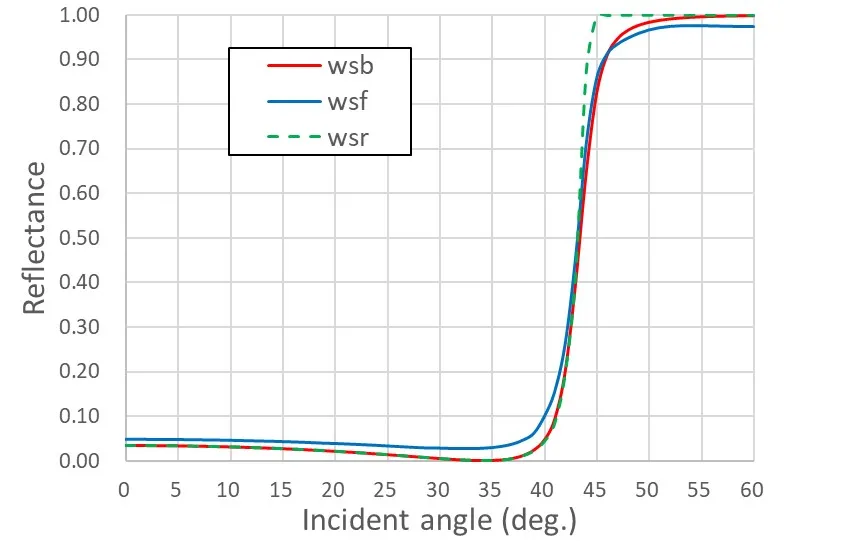
● Comparison for operation time and memory consumption.

● Although there is a difference where Wsf and Wsr show the Gaussian curve in the attenuation and Wsb shows the exponential one, they express the tunneling effect due to evanescent.
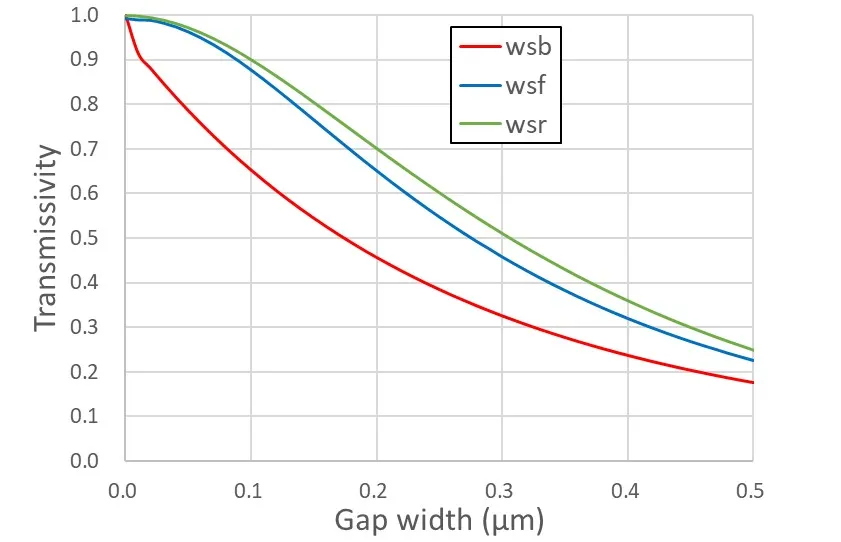
● Comparison for operation time and memory consumption.
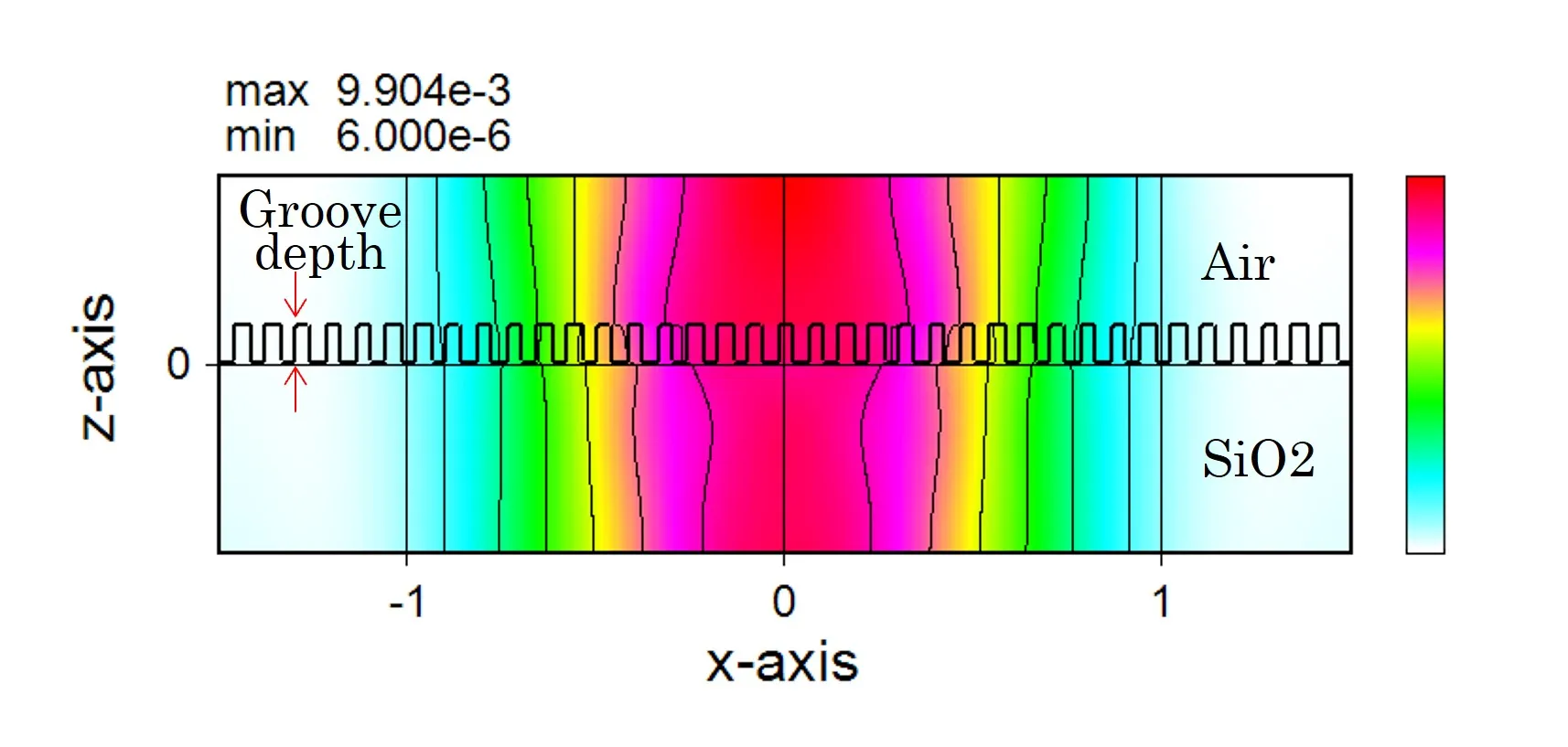
● The depth at which the reflectance is minimized is almost the same between Wsb, Wsf, and Wsr.
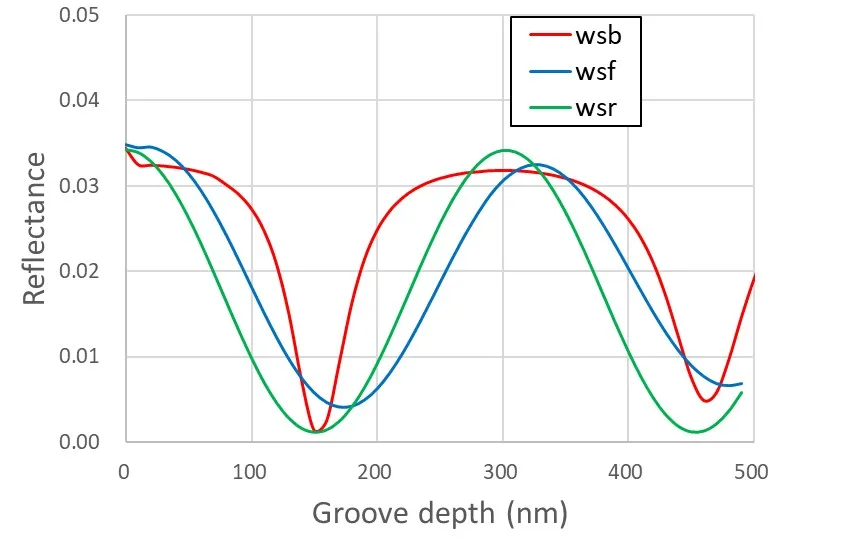
● Comparison for operation time and memory consumption.
● Calculated in Wsb (BPM).
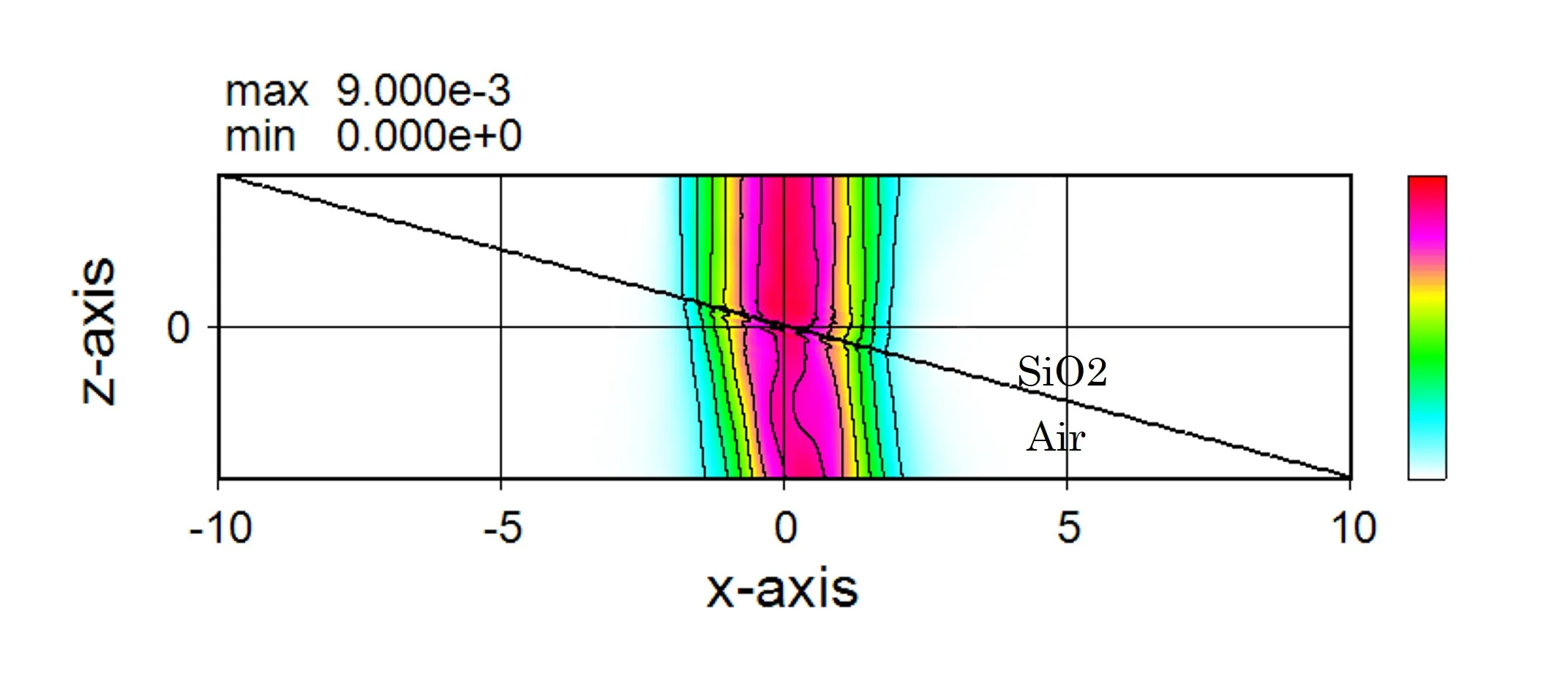
● Only the reflection component is extracted from the above calculation.
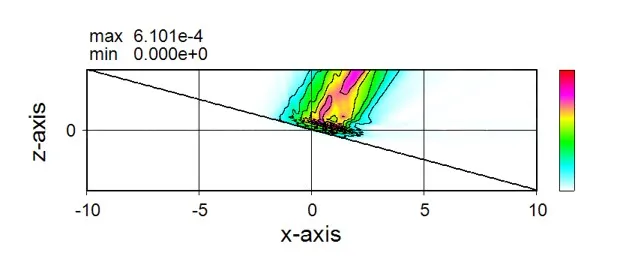
● Calculated in Wsf (FDTD).
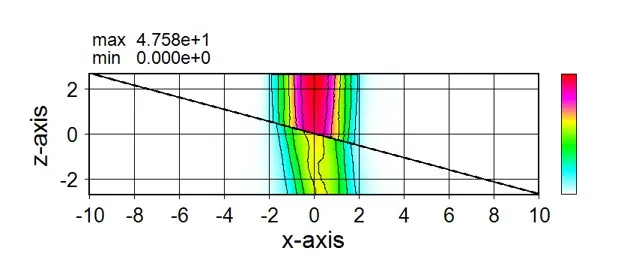
● Calculated in Wsr (RCWA).
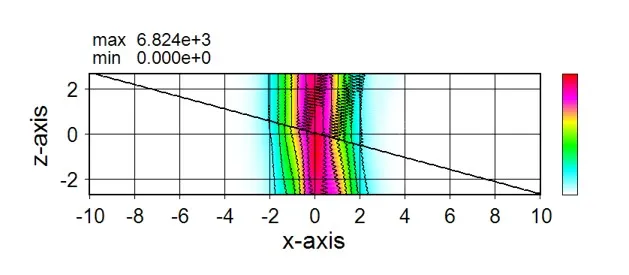
● Comparison for operation time and memory consumption.
● Calculated in Wsb (BPM).
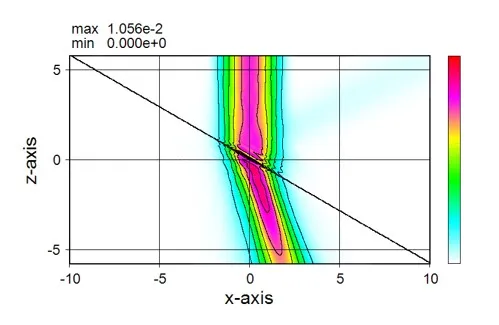
● Only the reflection component is extracted from the above calculation.
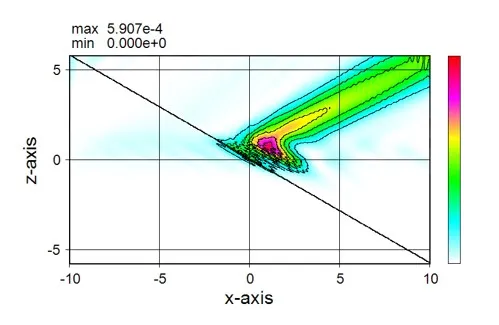
● Calculated in Wsf (FDTD).
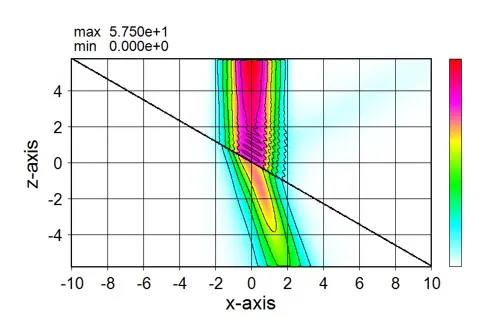
● Calculated in Wsr (RCWA).
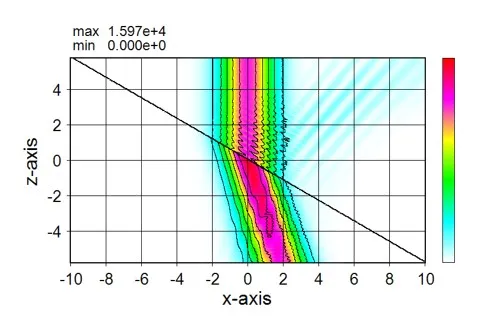
● Comparison for operation time and memory consumption.
● Calculated in Wsb (BPM). Since Wsb cannot handle light propagating horizontally (in the orthogonal direction of the z-axis), reflected light propagating horizontally does not appear.
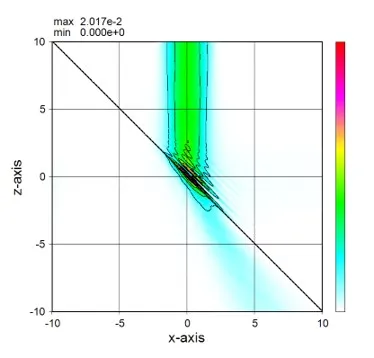
● Calculated in Wsf (FDTD). Reflected light appears, but it is partially scattered because the reflective surface is stepped.
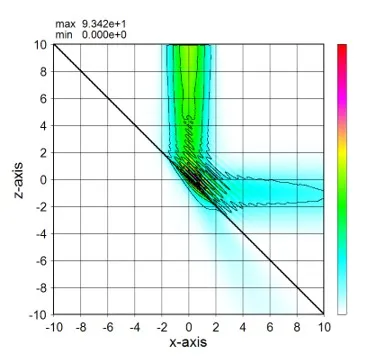
● Calculated in Wsr (RCWA). Reflected light appears, but it is partially scattered because the reflective surface is stepped.
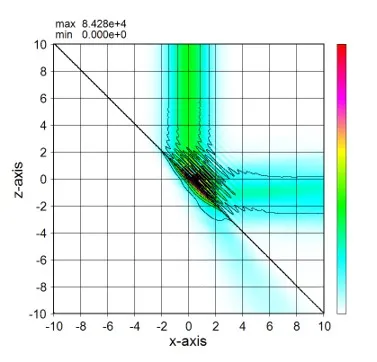
● Comparison for operation time and memory consumption.
● Calculated in Wsb (BPM). Reflected light appears, but it is partially scattered because the reflective surface is stepped.
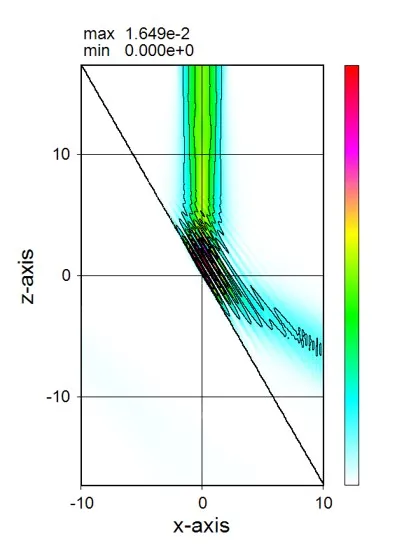
● Calculated in Wsf (FDTD). Reflected light appears, but it is partially scattered because the reflective surface is stepped.
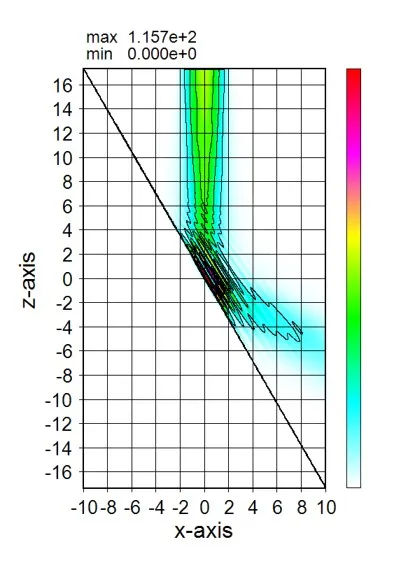
● Calculated in Wsr (RCWA). Reflected light appears, but it is partially scattered because the reflective surface is stepped.
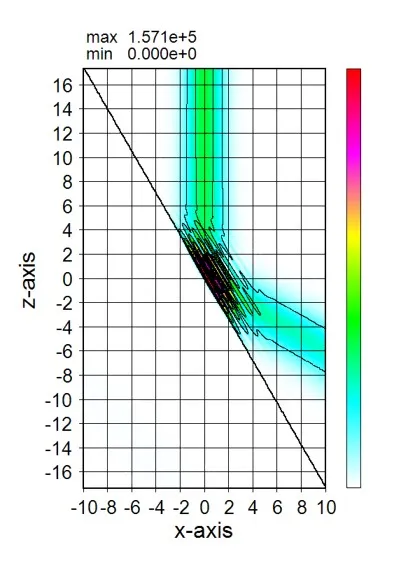
● Comparison for operation time and memory consumption.
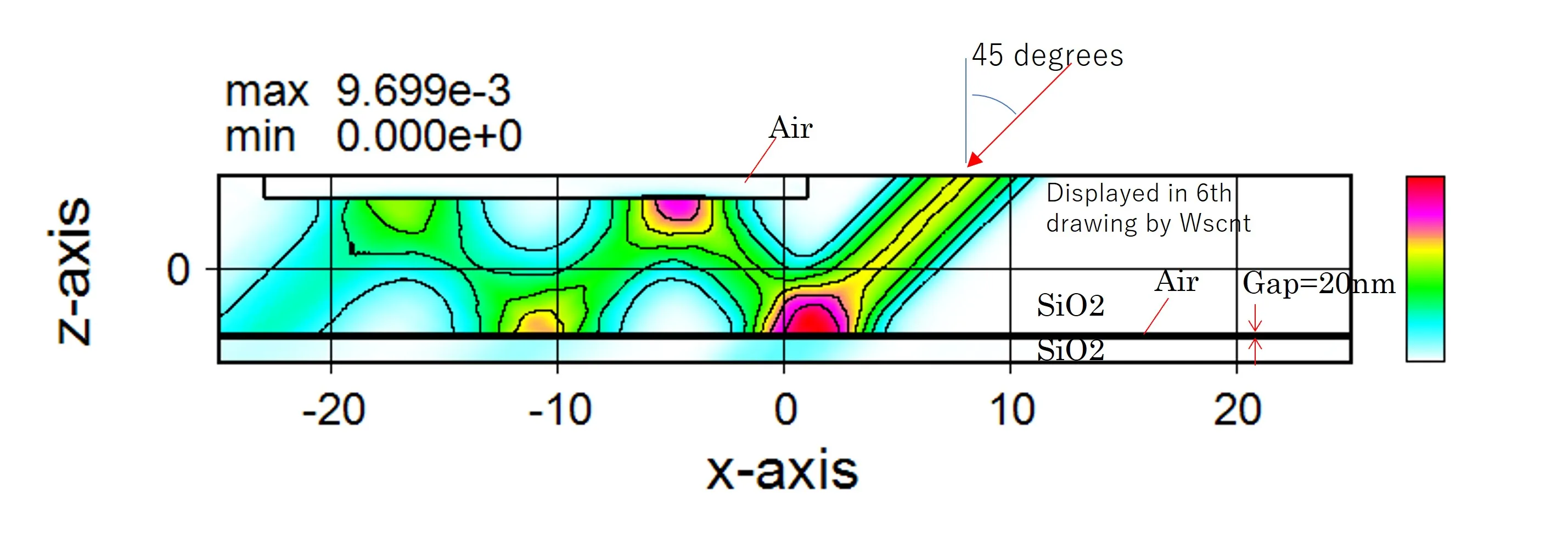
● Calculated in Wsb (BPM). As a comparison, the above figure is calculated with a non-interference setting (ity = 0), and the incident light and the reflected light are processed by the sum of the intensities, and no interference fringes appear.
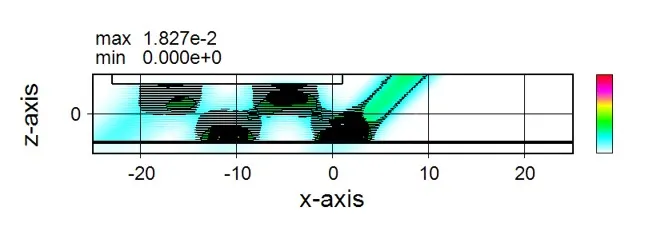
Setting screen for ity=0 and 1 in Wsems
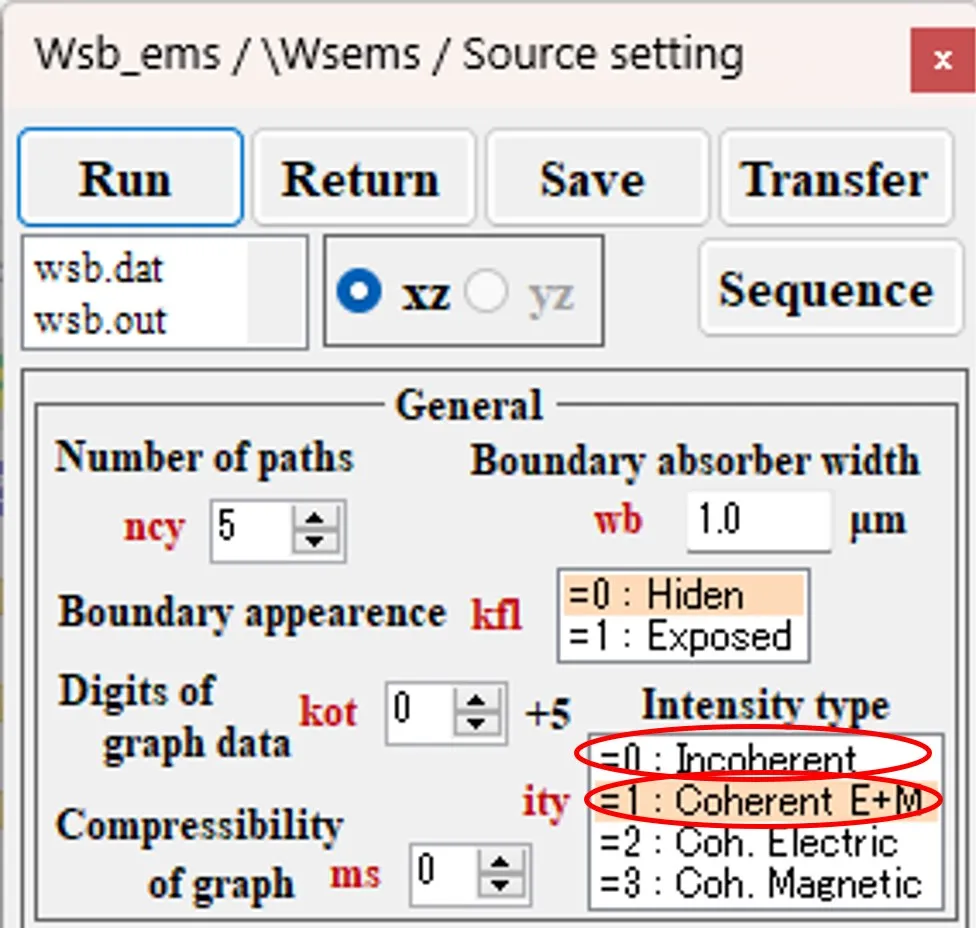
● Calculated in Wsf (FDTD).
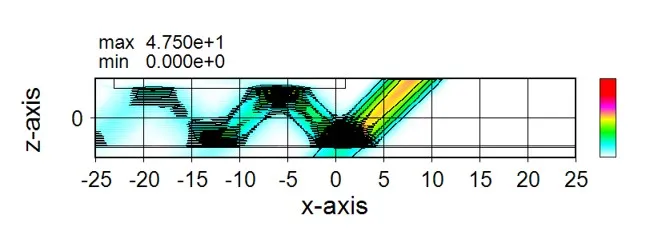
● Calculated in Wsr (RCWA).
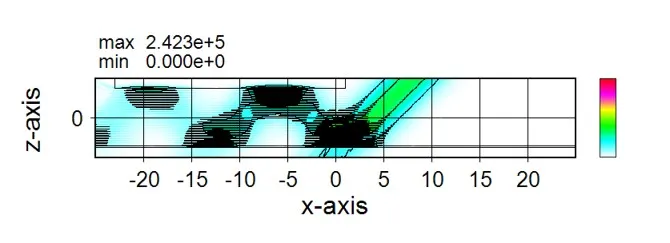
● Comparison for operation time and memory consumption.
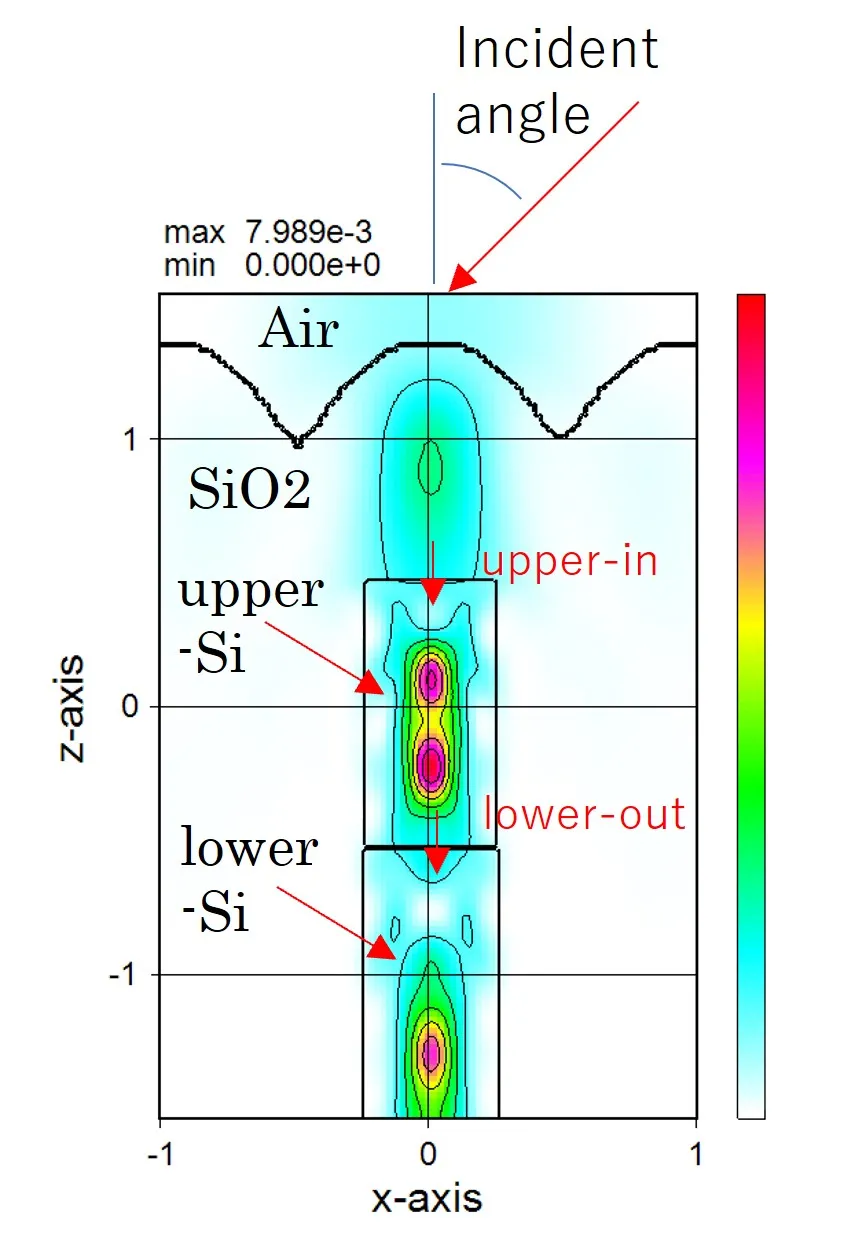
● Calculated in Wsb (BPM).
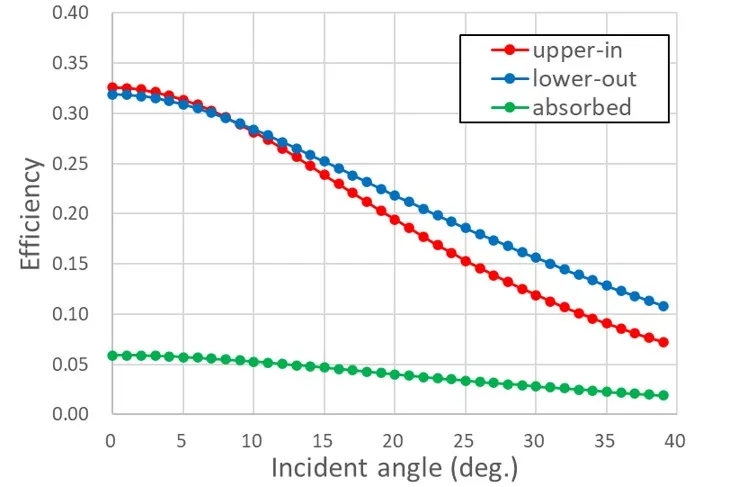
● Calculated in Wsf (FDTD).
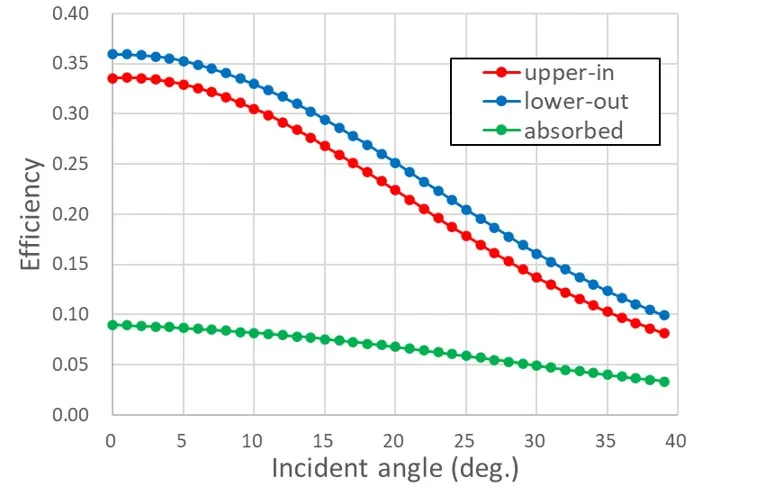
● Calculated in Wsr (RCWA).
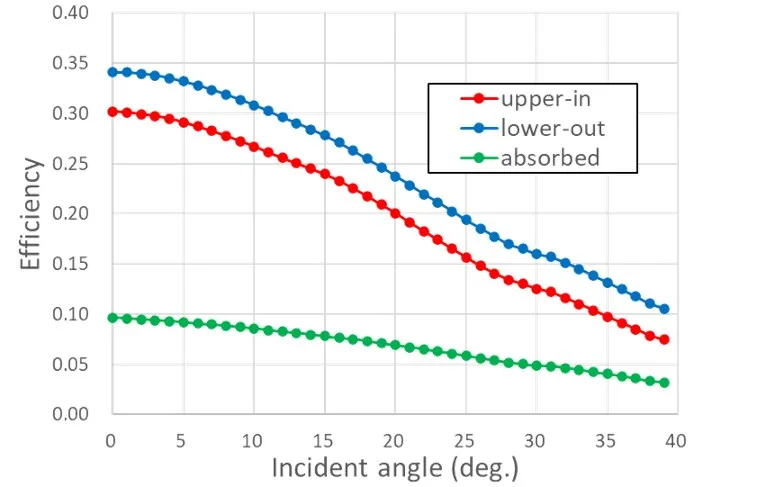
● Comparison for operation time and memory consumption.
Each of Wsb(BPM), Wsf(FDTD), and Wsr(RCWA) can calculate the same target.
● Calculation speed
Wsb is 100~300 times faster than Wsf, and Wsr is 1~10 times faster than Wsf.
● Memory consumption
Wsb requires 1/10~1/300 times (1~1/10 for 2-D calculation) and Wsr requires 1~10 times more memory than Wsf.
● Comparing with E.
Wsf(FDTD)
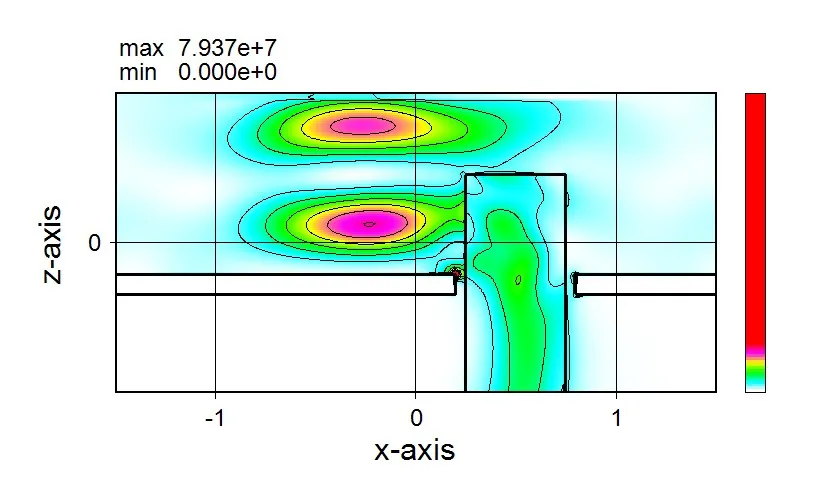
Wsr(RCWA)
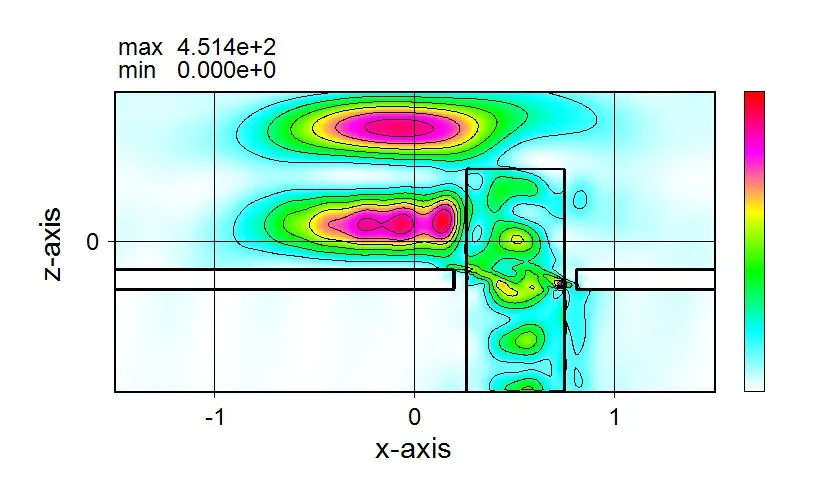
Wsb(BPM)
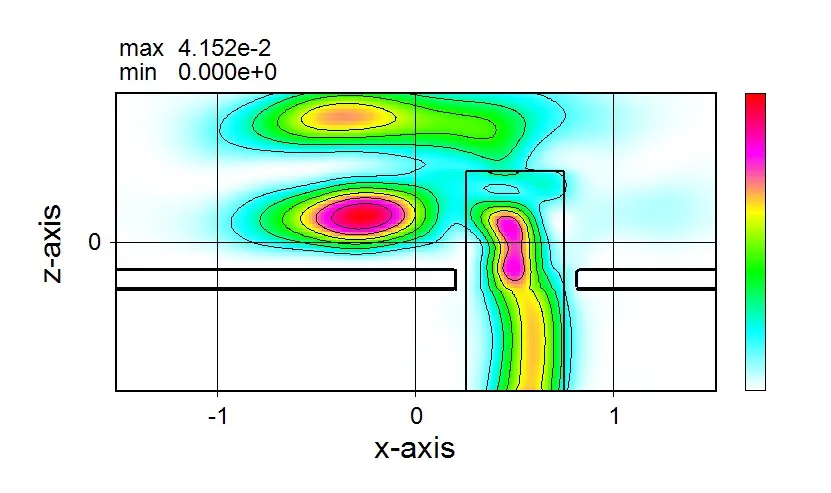
● Comparing with H.
Wsf(FDTD)
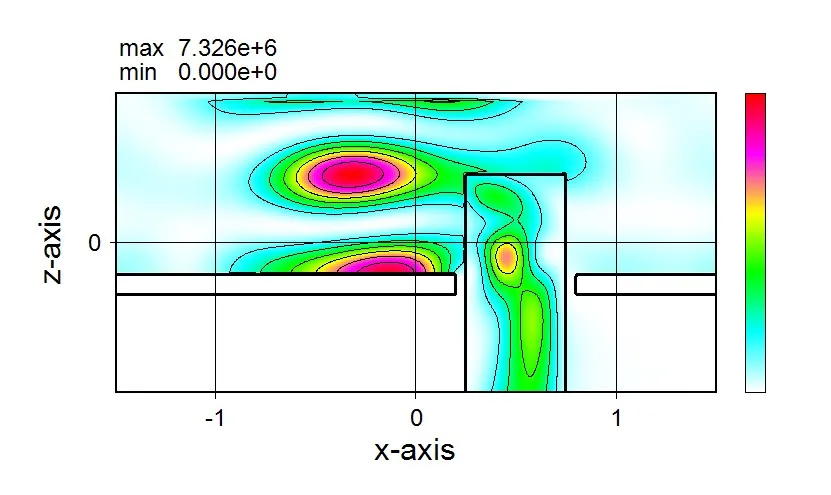
Wsr(RCWA)
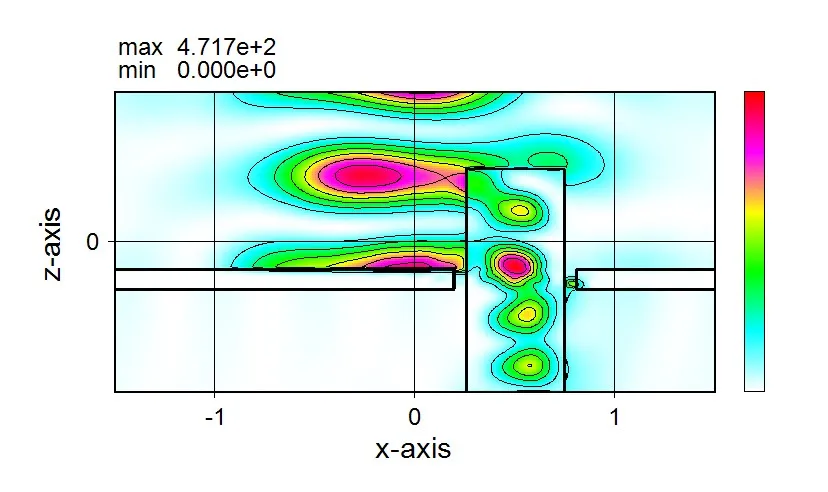
Wsb(BPM)
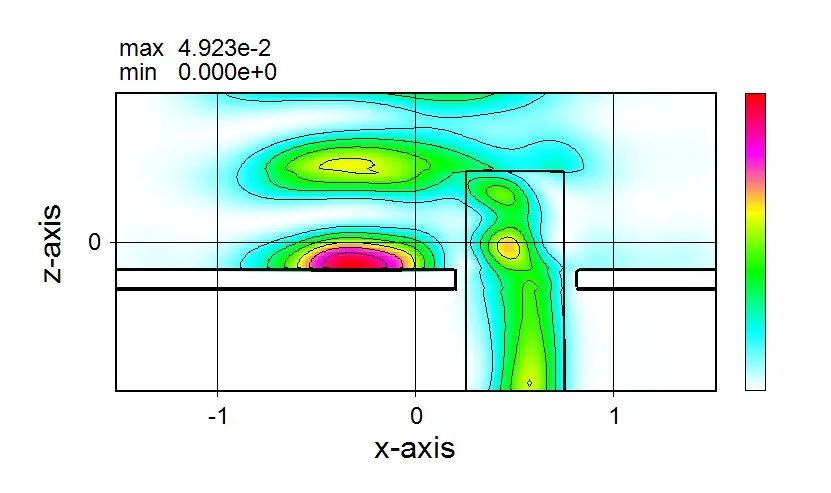
● Comparing with E+H.
Wsf(FDTD)
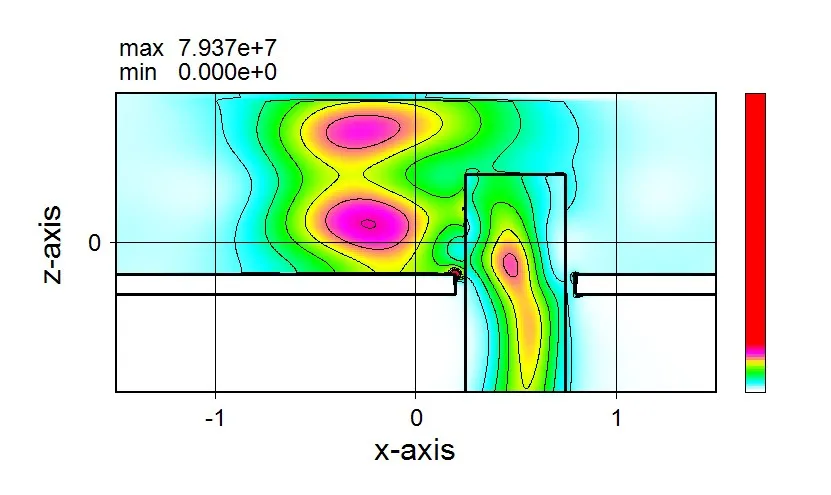
Wsr(RCWA)
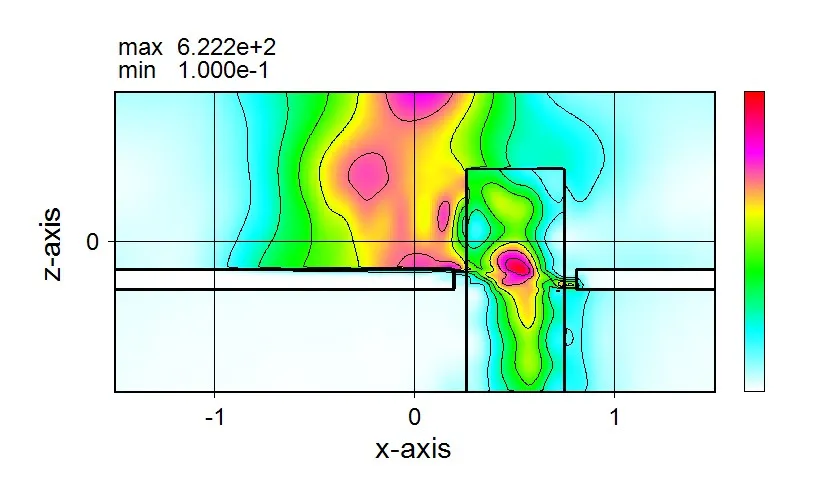
Wsb(BPM)
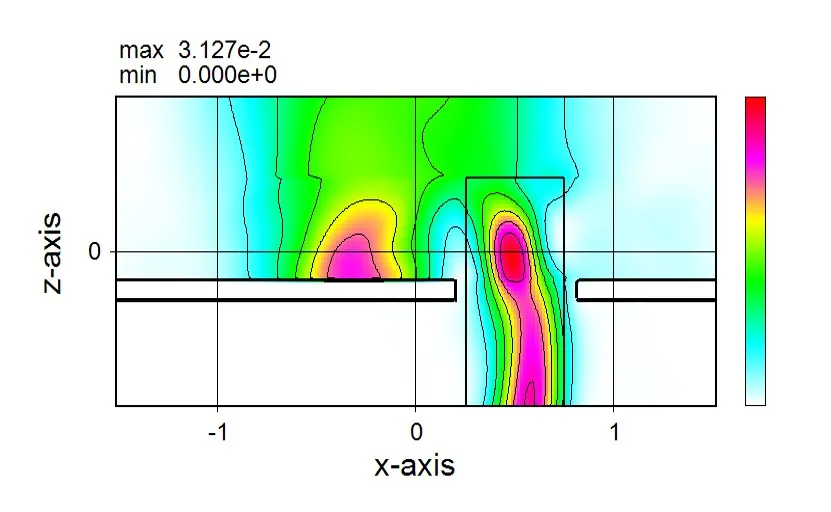
For Wsf and Wsr, a Poynting vector intensity parameter is also provided for the display of intensity distributions.
● Comparing with Poynting Vector.
Wsf(FDTD)
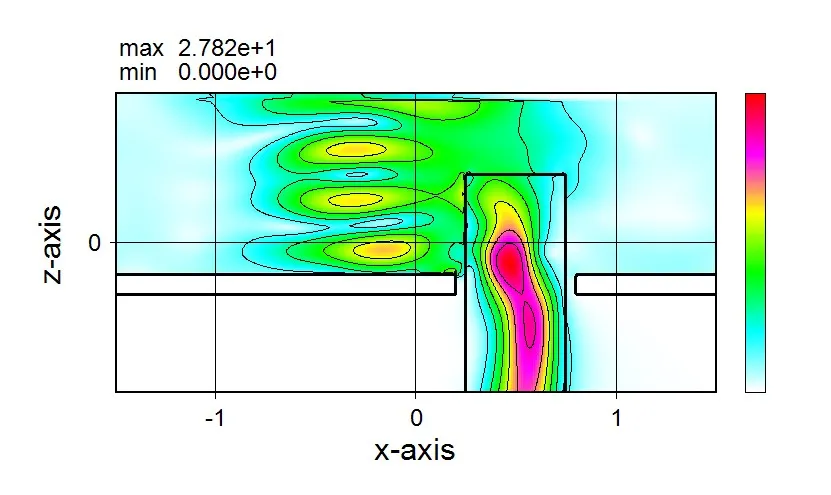
Wsr(RCWA)
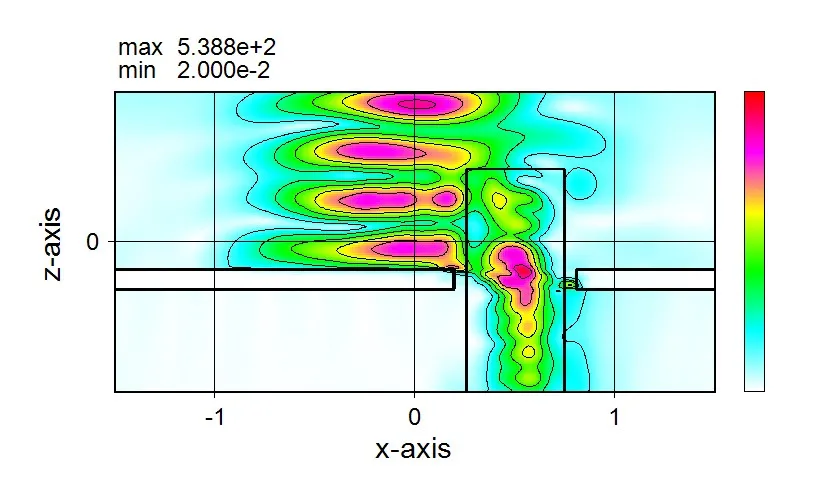
● 2. Tunneling effect due to evanescent
● 3. Reflectance characteristics due to anti-reflection structure
● 4. Reflection and refraction by a 15-degree inclination surface
● 5. Reflection and refraction by a 30-degree inclination surface
● 6. Reflection and refraction by a 45-degree inclination surface
● 7. Reflection and refraction by a 60-degree inclination surface
● 8. Tunneling effect due to evanescent and multiple reflections
● 9. Comparative Calculation of detection for splited material
● 10. Simulator comparison
Additional information
● 11. Light intensity distribution New 2024/11/12
The following comparison calculations are performed based on the data contained in the folder of "\Ws_soft\Samples\Comparison" in the distributed zip file.
1. Angular dependence of Fresnel reflection ▲top
● The reflectance of light incident on the SiO2/Air interface is calculated comparatively using the angle of incidence as a parameter. It is a problem of the angular dependence of the Fresnel reflection.
● Calculation results for P-polarization are compared between Wsb, Wsf, and Wsr, and they are almost the same. The reason why the result of Wsf rises around 35 degrees is due to the interference between the reflected light and the light source (where the incident light is set to a pulsed one to minimize this effect). The reason why roundness occurs around 45-50 degrees for the results of Wsb and Wsf is that the incident light contains a divergence component due to the small beam diameter.

● Comparison for operation time and memory consumption.
| 2D calculation data | Operation time | Memory consumption |
|---|---|---|
| wsb_1.dat | 1.2 s * 60 | 0.04 GB |
| wsf_1.dat | 78 s * 60 | 0.06 GB |
| wsr_1.dat | 7.1 s * 60 | 0.20 GB |
2. Tunneling effect due to evanescent ▲top
● The transmittance of P-polarized light incident at 45 degrees into the SiO2/Air/SiO2 gap structure is calculated comparatively using the gap thickness as a parameter. This is a problem of the tunneling effect, in which the evanescent component of the light incident on the upper surface to the air side and is trapped by the lower side SiO2.
● Although there is a difference where Wsf and Wsr show the Gaussian curve in the attenuation and Wsb shows the exponential one, they express the tunneling effect due to evanescent.

● Comparison for operation time and memory consumption.
| 2D calculation data | Operation time | Memory consumption |
|---|---|---|
| wsb_2.dat | 2.0 s * 50 | 0.04 GB |
| wsf_2.dat | 397 s * 50 | 0.02 GB |
| wsr_2.dat | 12.1 s * 50 | 0.37 GB |
3. Reflectance characteristics due to anti-reflection structure ▲top
● The reflectance of P-polarized light perpendicularly incident on the rectangular-cross-sectional lattice structure of SiO2 is comparatively calculated using the lattice depth as a parameter.
● The depth at which the reflectance is minimized is almost the same between Wsb, Wsf, and Wsr.

● Comparison for operation time and memory consumption.
| 2D calculation data | Operation time | Memory consumption |
|---|---|---|
| wsb_3.dat | 0.9 s * 50 | 0.01 GB |
| wsf_3.dat | 24 s * 50 | 0.06 GB |
| wsr_3.dat | 0.9 s * 50 | 0.02 GB |
4. Reflection and refraction by a 15-degree inclination surface ▲top
The reflection and refraction of P-polarized light incident on the 15-degree inclined plane of SiO2/Air is calculated here.● Calculated in Wsb (BPM).

● Only the reflection component is extracted from the above calculation.

● Calculated in Wsf (FDTD).

● Calculated in Wsr (RCWA).

● Comparison for operation time and memory consumption.
| 2D calculation data | Operation time | Memory consumption |
|---|---|---|
| wsb_4.dat | 3.7 s | 0.03 GB |
| wsf_4.dat | 66 s | 0.07 GB |
| wsr_4.dat | 133 s | 4.06 GB |
5. Reflection and refraction by a 30-degree inclination surface ▲top
The reflection and refraction of P-polarized light incident on the 30-degree inclined plane of SiO2/Air is calculated here.● Calculated in Wsb (BPM).

● Only the reflection component is extracted from the above calculation.

● Calculated in Wsf (FDTD).

● Calculated in Wsr (RCWA).

● Comparison for operation time and memory consumption.
| 2D calculation data | Operation time | Memory consumption |
|---|---|---|
| wsb_5.dat | 4.3 s | 0.04 GB |
| wsf_5.dat | 144 s | 0.11 GB |
| wsr_5.dat | 141 s | 4.06 GB |
6. Reflection and refraction by a 45-degree inclination surface ▲top
The reflection and refraction of P-polarized light incident on the 45-degree inclined plane of SiO2/Air is calculated here.● Calculated in Wsb (BPM). Since Wsb cannot handle light propagating horizontally (in the orthogonal direction of the z-axis), reflected light propagating horizontally does not appear.

● Calculated in Wsf (FDTD). Reflected light appears, but it is partially scattered because the reflective surface is stepped.

● Calculated in Wsr (RCWA). Reflected light appears, but it is partially scattered because the reflective surface is stepped.

● Comparison for operation time and memory consumption.
| 2D calculation data | Operation time | Memory consumption |
|---|---|---|
| wsb_6.dat | 8.3 s | 0.07 GB |
| wsf_6.dat | 416 s | 0.25 GB |
| wsr_6.dat | 182 s | 4.38 GB |
7. Reflection and refraction by a 60-degree inclination surface ▲top
The reflection and refraction of P-polarized light incident on the 60-degree inclined plane of SiO2/Air is calculated here.● Calculated in Wsb (BPM). Reflected light appears, but it is partially scattered because the reflective surface is stepped.

● Calculated in Wsf (FDTD). Reflected light appears, but it is partially scattered because the reflective surface is stepped.

● Calculated in Wsr (RCWA). Reflected light appears, but it is partially scattered because the reflective surface is stepped.

● Comparison for operation time and memory consumption.
| 2D calculation data | Operation time | Memory consumption |
|---|---|---|
| wsb_7.dat | 11.2 s | 0.11 GB |
| wsf_7.dat | 798 s | 0.39 GB |
| wsr_7.dat | 248 s | 5.23 GB |
8. Tunneling effect due to evanescent and multiple reflections ▲top
Calculation is performed to repeat the 45-degree reflection between the Al surface and the gap-structural surface of SiO2/Air/SiO2.
● Calculated in Wsb (BPM). As a comparison, the above figure is calculated with a non-interference setting (ity = 0), and the incident light and the reflected light are processed by the sum of the intensities, and no interference fringes appear.

Setting screen for ity=0 and 1 in Wsems

● Calculated in Wsf (FDTD).

● Calculated in Wsr (RCWA).

● Comparison for operation time and memory consumption.
| 2D calculation data | Operation time | Memory consumption |
|---|---|---|
| wsb_8.dat | 5.1 s | 0.07 GB |
| wsf_8.dat | 1229 s | 2.59 GB |
| wsr_8.dat | 155 s | 1.39 GB |
9. Comparative Calculation of detection for splited material ▲top
The rod-shaped Si material disposed in SiO2 under a lens is divided into upper and lower parts, and the amounts of P-polarized light transmitted at the upper and lower boundary surfaces of the upper half of the Si material and absorbed in the half reagion are calculated using the incident angle of light as a parameter. However, this calculation requires purchase because it specifies three or more types of materials other than air. (How to install and basic usage / Limitation)
● Calculated in Wsb (BPM).

● Calculated in Wsf (FDTD).

● Calculated in Wsr (RCWA).

● Comparison for operation time and memory consumption.
| 3D calculation data | Operation time | Memory consumption |
|---|---|---|
| wsb_9.dat | 2.0 s * 40 | 0.19 GB |
| wsf_9.dat | 510 s * 40 | 1.07 GB |
| wsr_9.dat | 198 s * 40 | 5.01 GB |
10. Simulator comparison ▲top
● Calculation targetEach of Wsb(BPM), Wsf(FDTD), and Wsr(RCWA) can calculate the same target.
● Calculation speed
Wsb is 100~300 times faster than Wsf, and Wsr is 1~10 times faster than Wsf.
● Memory consumption
Wsb requires 1/10~1/300 times (1~1/10 for 2-D calculation) and Wsr requires 1~10 times more memory than Wsf.
11. Light intensity distribution ▲top
The three softwares have parameters E (electric field intensity), H (magnetic field intensity) and E+H (electromagnetic field intensity) for displaying the intensity distribution in the Intensity type box on the Source setting window. Comparisons are made using wsf08, wsr08 and wsb05 in the folder¥Ws_soft¥Samples in the distribution zip as examples.● Comparing with E.
Wsf(FDTD)

Wsr(RCWA)

Wsb(BPM)

● Comparing with H.
Wsf(FDTD)

Wsr(RCWA)

Wsb(BPM)

● Comparing with E+H.
Wsf(FDTD)

Wsr(RCWA)

Wsb(BPM)

For Wsf and Wsr, a Poynting vector intensity parameter is also provided for the display of intensity distributions.
● Comparing with Poynting Vector.
Wsf(FDTD)

Wsr(RCWA)
